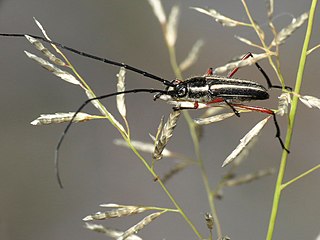
The whirligig beetles are water beetles, comprising the family Gyrinidae that usually swim on the surface of the water if undisturbed, though they swim underwater when threatened. They get their common name from their habit of swimming rapidly in circles when alarmed, and are also notable for their divided eyes which are believed to enable them to see both above and below water. The family includes some 700 extant species worldwide, in 15 genera, plus a few fossil species. Most species are very similar in general appearance, though they vary in size from perhaps 3 mm to 18 mm in length. They tend to be flattened and rounded in cross section, in plain view as seen from above, and in longitudinal section. In fact their shape is a good first approximation to an ellipsoid, with legs and other appendages fitting closely into a streamlined surface. Whirligig beetles belong to the beetle suborder Adephaga, which also includes ground beetles and diving beetles.

Noteridae is a family of adephagan water beetles closely related to the Dytiscidae, and formerly classified with them. They are mainly distinguished by the presence of a distinctive "noterid platform" underneath, in the form of a plate between the second and third pair of legs. The family is found worldwide, more commonly in the tropics. They are sometimes referred to as burrowing water beetles.

The Dytiscidae – based on the Greek dytikos (δυτικός), "able to dive" – are the predaceous diving beetles, a family of water beetles. They occur in virtually any freshwater habitat around the world, but a few species live among leaf litter. The adults of most are between 1 and 2.5 cm (0.4–1.0 in) long, though much variation is seen between species. The European Dytiscus latissimus and Brazilian Megadytes ducalis are the largest, reaching up to 4.5 and 4.75 cm respectively. In contrast, the smallest is likely the Australian Limbodessus atypicali of subterranean waters, which only is about 0.9 mm (0.035 in) long. Most are dark brown, blackish, or dark olive in color with golden highlights in some subfamilies. The larvae are commonly known as water tigers due to their voracious appetite. They have short, but sharp mandibles and immediately upon biting, they deliver digestive enzymes into prey to suck their liquefied remains. The family includes more than 4,000 described species in numerous genera.
Catherine N. Duckett is the Associate Dean of the School of Science at Monmouth University. Formerly she worked as Associate Director of the Office for the Promotion of Women in Science, Engineering and Mathematics, and the Program Manager of the Ocean Biogeographic Information System at Rutgers University, as well as a former Associate professor of Biology at University of Puerto Rico at Rio Piedras. She is also a prominent systematic entomologist, specializing in the phylogeny of flea beetles, and an adjunct professor at Rutgers.

Hydrocanthus is a genus of beetles in the family Noteridae, containing the following species:

Suphisellus is a genus of beetles in the family Noteridae.
Callistochroma cacica is a species of long-horned beetle in the family Cerambycidae.
Pilostenaspis lateralis is a species of long-horned beetle in the family Cerambycidae.
Crioprosopus servillei is a species of long-horned beetle in the family Cerambycidae.
Callistochroma viridipennis is a species of long-horned beetle in the family Cerambycidae. It was described by Pierre André Latreille in 1811.
Liocanthydrus armulatus is a species of water beetle in the family Noteridae. It is only known from the state of Bolívar, Venezuela.

Gyrininae is a subfamily of ground and water beetles in the family Gyrinidae. There are at least 740 described extant species in Gyrininae.

Sphaenothecus bilineatus, the double-banded bycid, is a species of long-horned beetle in the family Cerambycidae.
Callistochroma is a genus of long-horned beetles in the family Cerambycidae. There are about seven described species in Callistochroma.
Pilostenaspis is a genus of long-horned beetles in the family Cerambycidae. There are at least three described species in Pilostenaspis.
Megapurpuricenus is a genus of long-horned beetles in the family Cerambycidae containing one described species, M. magnificus.

Aspidytidae is a family of aquatic beetles of the suborder Adephaga, described in 2002 from specimens in South Africa and China. There are only two known species in the family and these were originally described in the genus Aspidytes, but later the new genus Sinaspidytes was erected for the species found in China. The family can also be referred to by its trivial name cliff water beetles.

Globulosis is a Neotropical genus of water scavenger beetle in the family Hydrophilidae represented by two described species known from the Guiana Shield Region.
Liocanthydrus is a genus of beetles belonging to the family Noteridae, the burrowing water beetles. The genus is Neotropical with records from Brazil, Venezuela, French Guiana, and Paraguay. It was originally established as a subgenus of the otherwise Old World genus Canthydrus.








